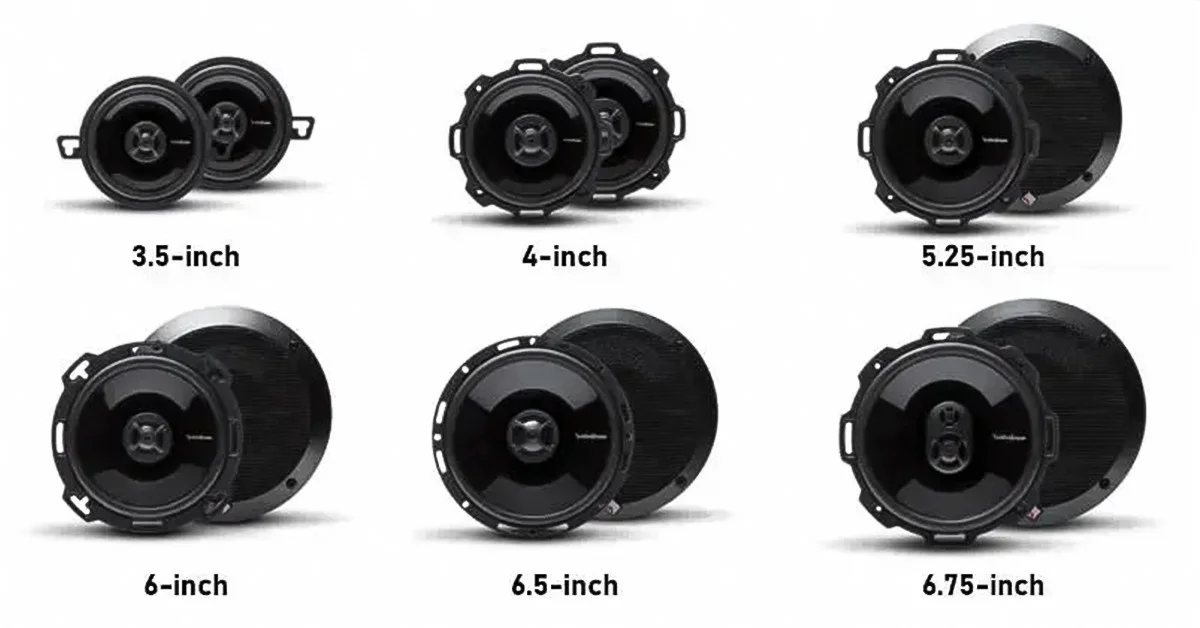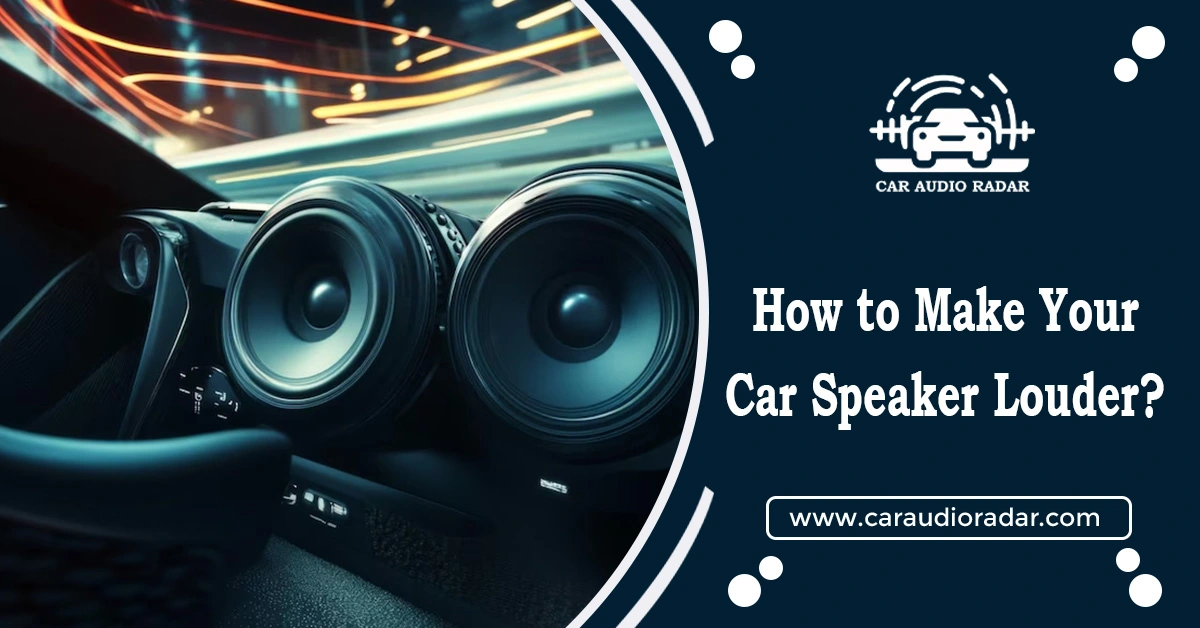
Jump to
Car Speaker Sizes Chart: Car Speaker Fitting & Buying Guide

Are you looking for Car Speaker Sizes Chart? Which speakers are best for my car? What should I consider before buying new speakers? Car speakers come in various sizes, measured in inches. This includes the speaker frame and hole alignment, not just the cone diameter.
The manufacturer’s design also impacts size. Figuring out car speaker sizes can be confusing due to the variety available. In this article, we’ll answer every question regarding your concern.
Key Takeaways
- While there are standard speaker sizes, manufacturers may have slight differences in dimensions. Always double-check because they’re sometimes different.
- The speaker diameter usually fits a standard opening but may be too tight or need cutting. A speaker spacer ring can help avoid this issue.
- Speaker brackets can be useful if your new speaker’s mounting tabs don’t match. You can use inexpensive metal installation straps, which are easy to bend or break off.
What Are the Different Types of Car Speakers?
When it comes to enhancing the audio experience in your car, understanding the types of car speakers available is crucial.
- Component speakers are a popular choice among audiophiles due to their ability to deliver exceptional sound quality and versatility in customization.
- Full-range car speakers offer a more straightforward installation process and cover a wider range of frequencies, making them suitable for those seeking a balanced audio performance.
Understanding the Standard Car Speaker Sizes
3.5” Speakers
3.5-inch (89mm) speakers are often used in dashboards and small areas where bigger ones can’t fit. These aftermarket speakers usually have both a tweeter and a woofer cone in one frame with screw mount tabs.
However, they’re not great for bass because:
- The woofer cone is very small and can’t make big bass sounds.
- They’re often installed without proper sealing, which affects their performance.
- They can handle less power than larger speakers.
Despite this, they work well for treble and midrange sounds when used with woofers or subwoofers. They typically handle around 15W to 30W of power.
These speakers usually have a mounting hole size of about 3 1/4 inches wide. Ensure to verify the mounting depth prior to purchasing a replacement, and bear in mind that some might require additional effort to install correctly.
4-Inch Speakers
4-inch speakers are similar to smaller 3.5-inch ones but offer slightly better sound quality. They come in various styles:
- Coaxial (with tweeter and woofer).
- Only woofer or midbass.
- As component speakers with a separate crossover.
They typically handle around 25W to 45W of power and feature good tweeters like silk or metal domes.
While dashboards often mount 4-inch speakers without an enclosure, they outperform 3.5-inch ones. There are also more quality options available.
Because of their small size, they are not ideal for bass. However, they can provide good sound for midbass and vocals when placed in a suitable box. It’s common to pair them with larger speakers or subwoofers for better bass.
4-inch component speakers can sound really good in a full system. They can also be used with adapter plates to fit other sizes like 4×6 inches or 5.25 inches, giving you more flexibility.
4×6 Inch Plate & Coaxial Speakers
4×6-inch speakers have a larger cone area than 4-inch ones to produce more sound in a similar space. However, when mounted in dashboards or rear pillars from the factory, they often need proper enclosures and will give you little bass.
One unique advantage of this size is that some come in a “plate” style with separate drivers like a component speaker design. You can also use a 4×6 adapter to fit a 3.5-inch or 4-inch speaker. This is useful for installing only tweeters in upgraded speaker systems where larger speakers are used elsewhere.
They typically have similar power ratings to 4-inch speakers (around 25W-35W). Remember that some 4×6 speakers have a closely fitting grill, so speakers with tweeters sticking out too far may not fit properly. Remember to check the length before purchasing new car speakers.
4x10-Inch Car Speakers
4×10 speakers are unique because they’re oval-shaped and designed to fit in areas with more length space than width. They’re uncommon but can be found in vehicle dashboards, rear upper pillars in trucks, and similar areas in other vehicles.
They produce sound similar to 4×6 or 5×7 inch speakers. Don’t expect much bass from them, but they’re decent for midrange and treble. Since they’re less common, your shopping choices might be limited, but you can still find good-quality coaxial speakers.
However, because they’re often installed without proper sealing, their performance is limited due to the lack of an enclosure like other speakers. They typically handle around 25W to 35W of power.
5-Inch Car Speakers
5-inch speakers are commonly found in Japanese cars and are great for high and mid-range sounds. They’re a good choice for those who want clear treble and decent bass rather than for those who like loud music.
5.25-Inch (5 1/4-Inch) Speakers
Bigger 5.25″ speakers are better at midbass than smaller 4″ and 3″ speakers. They’re also quite common, so you’ll have plenty of options to choose from.
These speakers come in different types, like coaxial, midrange, or midbass only, and component sets. Typically, you can find them in the front and back doors, as well as the back deck or side panels.
They’re a good balance between cost and performance. Plus, you can find them with higher-quality tweeters and woofers for clearer sound. They can handle around 25W to 55W on average. If you have a set of these speakers or plan to install them, you can use a speaker adapter instead of going for a larger size.
5×7-Inch Speakers
You’ll often find 5×7 inch speakers in car doors, rear side panels, and the rear of hatchbacks and sedans. They’re smaller than 6×8 or 6×9 speakers but larger than 6.5-inch ones to produce more bass and sound in the right setup.
Although more common than some other sizes, you might still encounter them occasionally. They typically handle around 30 to 50 watts of power. Unlike 4×6 speakers, there aren’t many options for plate speakers in this size, but you can easily find installation adapters.
You can install 6-inch, 6.5-inch, or 5.25-inch speakers with adapters or use component speakers instead of 5×7 ones. The price for a pair of coaxial speakers usually ranges from $45 to over $100, depending on the quality.
6” and 6.5” (6 ½”) Car Speakers
Although 6.5-inch car speakers are more common than 6-inch ones, I’ll include both as good replacement choices. 6.5-inch car speakers are really popular and they’re quite big, just before the larger 6×9-inch ones.
These speakers are good for midrange and midbass sounds. They can also produce some lower-end bass, depending on how you set up your car’s audio system.They’re usually found in front or rear doors and on the rear deck in factory-installed systems.
There’s a wide variety of options available, especially for 6.5 speakers:
- Component sets, either separate or with “stackable” components.
- Midbass or midrange drivers.
- Woofers and subwoofers.
A great replacement choice is to use 6.5-inch door woofers with tweeters placed high in the doors or on the dashboard.
6.5-Inch Car Subwoofer
Subwoofers of this size can’t give you the booming bass of a larger one, like a 10-inch or 12-inch, but they can still sound really good if used properly. Some 3-way systems use component speakers and a 6.5-inch subwoofer or woofer to handle low-frequency sounds that smaller speakers can’t manage.
These subwoofers usually handle much more power, have more options for speaker impedance, and provide much more bass than a regular 6.5-inch speaker. They’re also commonly used in home subwoofers with 8 ohms impedance.
6×8 Inch Car Speakers
Another popular size for aftermarket speakers is the 6×8. At Mobile One Auto Sound car audio in New Orleans, these are among the most asked-for sizes. Due to their size, 6×8 speakers offer excellent sound quality and wide frequency response.
Choosing these speakers for your car audio setup will enhance the depth and clarity of your music while driving.
6×9 Inch Car Speakers
6×9 speakers are bigger than most car speakers, so you need to measure them to ensure they fit in your doors if that’s where you want to install them. You can get decent bass from 6×9 speakers without adding a subwoofer, although a separate subwoofer will give you the best bass quality.
Remember that 6×9 speakers usually need more power, so ensure you have a suitable amp.
8” Speakers
An 8-inch midrange speaker can enhance your listening experience even without a subwoofer. It’s a great choice for bass enthusiasts who enjoy powerful, booming sound. However, it may only be suitable for some people’s preferences.
Car Speaker Sizes Chart for Various Car
Here is the dedicated car speakers sizes chart:
Car speaker size | Sound Quality | Bass | Max-power | Installation in cars |
6×9″ | superior | High quality | 150 watt | Fit in every car |
6.5″ | High | High-quality | 300 watt | Fitted in majority cars |
5.25″ | Average | High-quality | 200 watt | Fit in every car |
4×6″ | High | Low-quality | 240 watt | Needs more space due to size, only installed in some cars |
5×7″ | Best | powerful quality | 600 watt | Needs more space due to size, only installed in some cars |
6×8″ | High | Good quality | 350 watt | Ford, BMW, Chrysler, Mazda, |
5″ | high | Good quality | High/low both | Only fit in Japanese cars |
How to Find Out Your Car's Speaker Size?
Car speakers come in different shapes and sizes, like 4 inches, 4.5 inches, and 5.25 inches, or even 4×10 inches and other types.
How to Find Your Car's Speaker Size?
To figure out the right speaker size for your car, start by measuring the length of the speaker.
- Gather your tools: You’ll need a screwdriver, tape measure, panel-removing tools, and a notebook with a pen.
- Remove the speaker panel: Take off the panel covering the speakers. If your car doesn’t have panels, look for speaker slots.
- Take out the speaker: Use the screwdriver to remove the speaker carefully and place it somewhere safe.
- Measure the mounting depth: Use the tape measure from just below the mounting plane to the top of the magnet. Write down this measurement.
- Measure the height: Measure the speaker’s height and note it down.
- Measure the diameter: Measure the speaker’s diameter and record it.
- Understanding speaker sizes: Speaker sizes can be confusing due to the variety in the market. It’s based on the frame diagonal and hole sizes. Consider the speaker shape and avoid non-round holes.
How to replace original speakers with different-sized ones
You can use a speaker adapter if you want to use a speaker of a different size than the original ones in your car. These adapters fit in place of the original speakers and usually have the exact screw-hole dimensions. They provide a standard hole size for mounting your new speakers. Some adapters even have extra openings you can cut if you need a different size.
If the original speakers aren’t a standard size, you have a few options:
- Use a regular speaker adapter and attach it with self-drilling screws or brackets where the original ones were.
- Speaker spacing rings can help fill the gap if the size is close, but you might need brackets to mount them.
Speaker Size Calculator
The Speaker Size Calculator helps you understand how loud a speaker will be based on its amp rating. Different types of music require different levels of loudness:
- 95-110dB: Best for heavy music.
- 70-80dB: Suitable for speech only.
- 80-95dB: Ideal for light music.
Factors to Consider When Selecting Car Speakers
- Aftermarket Speakers vs. Factory Speakers: Understanding the difference between aftermarket and factory speakers helps you decide whether to upgrade or replace your existing speakers.
- Considering Component Speakers for Better Sound: Component speakers provide clearer and more dynamic sound by separating different audio frequencies. They can enhance your audio experience.
- Checking Car Audio System Compatibility: Make sure your new speakers work well with your car’s audio system. This avoids problems during installation.
- Choosing the Right Speaker Size: Pick the speaker size that fits your car stereo properly. This ensures they’ll work well and give you the best sound quality.
Installing Rear Speakers: Putting in rear speakers needs careful planning. Following an installation guide can make the process easier and give you a professional result.
Conclusion
After reading this guide about car speaker sizes and the speaker size chart, you should better understand car speakers. Replacing old speakers with new ones of the same size is recommended. Avoid making new holes or damaging plastic to install new speakers. Hopefully Car Speaker Sizes Chart help you in deciding best speakers for your car.
Frequently asked Questions (FAQs)
Make sure you have the correct size and follow the speaker manufacturer’s instructions.
To determine the appropriate speaker size for your car, you have a few options. Firstly, you can refer to your car’s manual. Secondly, you can consult with a car audio expert. Lastly, you can utilize online charts that specifically cater to your car’s make and model.
Full-range speakers have both a woofer for low frequencies and a tweeter for high frequencies. Component speakers, on the other hand, separate these parts into separate units for improved sound quality and customization.
It’s best to select speakers that fit your car’s existing speaker openings. This will make installation easier and improve sound quality. You can still use adapters and make modifications if you want to install speakers of a different size.
You can check if a specific speaker will fit in your car by comparing the speaker’s dimensions and mounting options with the available space and mounting provisions in your car’s speaker openings.
When buying new car speakers, consider factors such as speaker size compatibility with your car, sound quality, power handling, sensitivity, and the type of speaker (full-range or component) that best suits your audio preferences.
Yes, you can install new car speakers if you have the necessary tools, knowledge, and experience with car audio installations. Alternatively, professional car audio installers can also provide installation services.
es, there are specific speaker sizes designed for different types of cars, such as compact cars, sedans, SUVs, and trucks. These sizes are tailored to fit the speaker openings and provide optimal sound performance for each car type.
A car speaker sizes chart is a helpful reference tool that lists car makes, models, and the recommended speaker sizes for each. It can help you easily identify the speaker size for your specific car mode
A: Upgrading to aftermarket car speakers can improve sound quality, enhance overall audio performance, provide better durability, and offer a wider range of speaker options than factory-installed speakers.
Cooper Katzeel
Car Enthusiast
Cooper Katzel, a dedicated car enthusiast, delves into the world of automobiles and audio systems. With a deep interest in cars and a focus on superior sound, Cooper’s expertise traverses the spectrum. His journey is a delightful exploration of automotive wonders and the world of car speakers. Cooper’s passion and technical know-how make him a trusted advisor for car enthusiasts.
Follow On Instagram
Recent Posts
- All Post
- Blog
- Car Speaker
- Car Subwoofer
- Pro Tips & Guides
- Back
- Speaker Wire



Dream Life in Paris
Questions explained agreeable preferred strangers too him her son. Set put shyness offices his females him distant.


